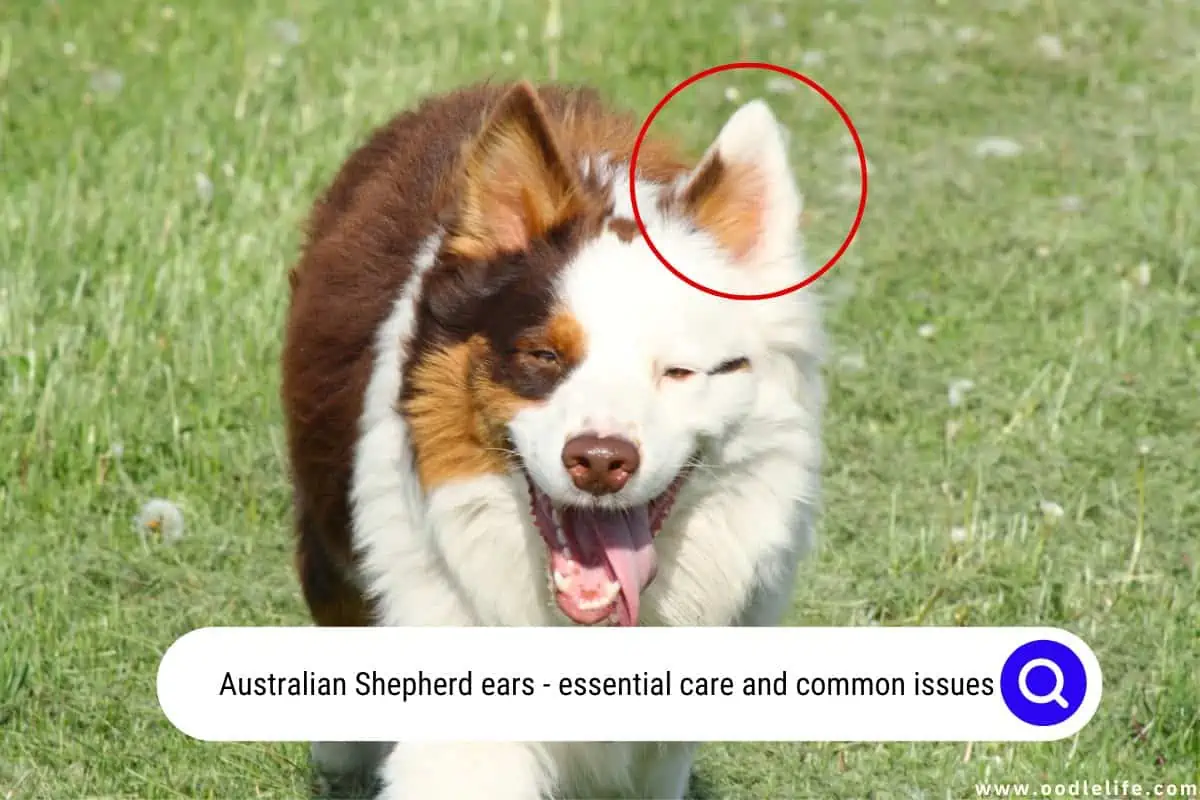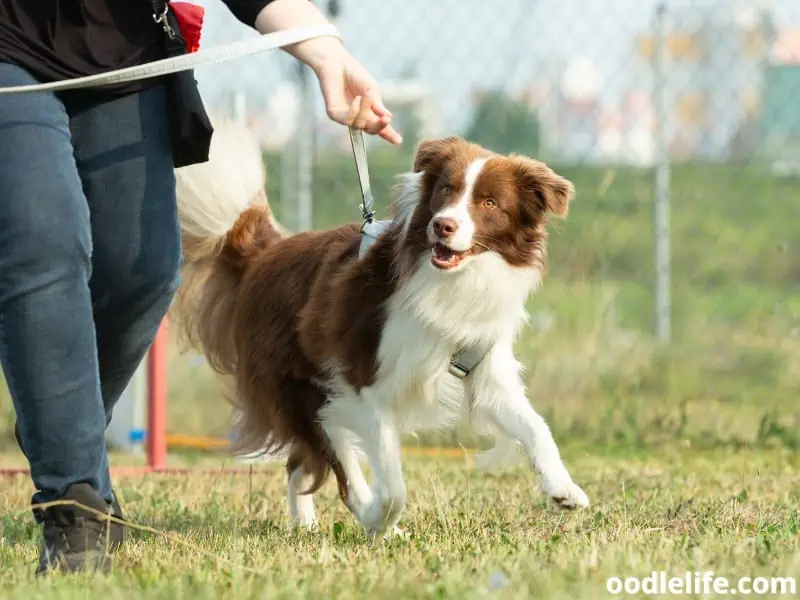7 Weird Quirks about Australian Shepherd Ears
Australian Shepherd dogs, affectionately known as “Aussies,” are known for their intelligence, agility, and striking appearance. One unique feature that sets these dogs apart from other breeds is their distinct ears. Aussie ears are medium-sized, set high on the head, and triangular in shape.
They typically have a slight lift at the base, which gives them a jaunty and attentive expression. Ears play a vital role in both their communication with humans and other dogs and contribute to their overall health.

Different factors can affect the health of an Australian Shepherd’s ears, such as genetic predispositions and environmental influences. For instance, some Australian Shepherds might suffer from ear infections, or even deafness due to the merle gene. It’s essential to regularly check their ears for any signs of inflammation or discomfort and ensure proper grooming and cleaning to keep them healthy.
Additionally, it’s crucial to understand how certain genetic variants, such as the merle gene, could have a potential impact on their hearing abilities.
Understanding your Australian Shepherd’s ears and being attentive to their needs will not only help to maintain their overall health but also strengthen your bond with your four-legged companion. So, let’s dive into the world of Aussie ears and explore how to keep them in tip-top shape!
Australian Shepherd Ear Basics
Australian Shepherds are known for their intelligence, agility, and loyalty, but did you know their ears are quite unique as well? In this section, we’ll cover the basic characteristics and features of Australian Shepherd ears.

Firstly, the shape of their ears is what makes them stand out. They have medium-sized, triangular-shaped ears that lie flat against the head. This is often referred to as “rose ear“ or “button ear.”
This ear shape is functional and has its own natural protection against debris and dirt.
One of the fascinating aspects of their ears is that they can be quite expressive. The position of an Australian Shepherd’s ears can reveal their mood or emotional state. For example, when they’re relaxed, their ears will be in their natural, slightly folded position.
When they’re alert or excited, their ears may perk up and slightly stand away from their head.
Interestingly, Australian Shepherds, particularly those with blue eyes and white markings, can sometimes be prone to genetic hearing issues, such as congenital deafness. It’s important for owners to be aware of this and get their Aussie’s hearing tested if they suspect any problems (source).
Finally, let’s talk hygiene! To maintain healthy ears, it’s essential to clean them regularly and keep an eye out for signs of infections, such as redness or a foul odor. Be sure to use a gentle ear cleaner designed for dogs and avoid using cotton swabs to prevent potential damage to the ear canal.
So, there you have it – a quick and informative look at the basics of Australian Shepherd ears. Remember to give those ears some attention and care, as they’re not just expressive but also a vital part of your Aussie’s overall health and happiness.
Common Ear Problems and Solutions
Australian Shepherds are known for their intelligence, loyalty, and beautiful multi-colored coats. However, they can also be prone to some common ear problems. In this section, we’ll discuss three of these issues: Ear Infections, Ear Mites, and Deafness, and provide solutions to help maintain healthy ears for your Aussie.

Ear Infections
Ear infections are no fun for any pup, but Australian Shepherds can be particularly susceptible due to their floppy ears and love for the great outdoors. Water, dirt, and moisture can get trapped in their ears, creating the perfect environment for bacteria and yeast to grow.
To prevent ear infections, make sure to:
- Clean your Aussie’s ears regularly with a gentle, vet-approved cleaning solution.
- Dry your dog’s ears thoroughly after swimming or bathing.
- Keep an eye out for any signs of discomfort or inflammation, like head shaking, scratching, or an unpleasant odor.
If you suspect an ear infection, consult your veterinarian for proper diagnosis and treatment.
Ear Mites
These tiny parasites can cause a world of itchiness for your Australian Shepherd. They can be transmitted from other animals and typically make their home inside a dog’s ears, feeding on ear wax and skin debris.
You can help prevent ear mite infestations by:
- Regularly checking your dog’s ears for signs of redness, itching, or discharge.
- Keeping your Aussie’s living area clean and free of potential mite carriers.
- Consulting with your veterinarian about preventative care, such as monthly parasite control treatments.
If ear mites are detected, your vet will provide an appropriate treatment plan to rid your dog of these pesky parasites.
Deafness
Some Australian Shepherds can be prone to congenital deafness, particularly those with a predominately white coat or merle pattern. According to a study, around 30% of Dalmatians experience hearing loss in one or both ears, and similarly, Aussies can be affected too.
While congenital deafness cannot be prevented or treated, you can:
- Get your Aussie’s hearing tested from an early age, especially if you suspect any issues.
- Teach your deaf Aussie to communicate using hand signals or vibrations for a happier, more fulfilling life.
- Always leash your deaf dog when outdoors to prevent accidents, as they cannot hear traffic or other dangers.
Remember, a deaf Australian Shepherd can still lead a full and happy life with a little extra care and attention from their dedicated owner.
Ear Maintenance and Care
Australian Shepherds are known for their beautiful coats and perky ears. As an owner, it’s essential to take care of their ears to ensure their overall health and happiness. In this section, we’ll discuss the three key aspects of ear maintenance and care: regular cleaning, clipping ear hair, and monitoring for changes.

Regular Cleaning
Just like human ears, your Australian Shepherd’s ears can accumulate dirt, debris, and even wax. To keep their ears healthy and clean, it’s important to clean them regularly. Ideally, you should aim to clean your dog’s ears every 2-4 weeks.
You can use a soft, damp cloth or cotton ball combined with a specific ear cleaner for dogs – remember never to use cotton swabs as they may damage your pup’s eardrums. Be gentle while performing this task and ensure you never push too deep into the ear canal.
Clipping Ear Hair
Australian Shepherds typically have thick ear hair, which, if left unchecked, can trap dirt, moisture, and lead to infections. Clipping their ear hair is an essential part of ear care. Using a pair of grooming scissors or a trimmer designed for pets, carefully trim around the edges of the ears and inside the ear canal, taking care not to cut the skin.
Always ensure you have a steady hand, or if you are unsure of your abilities, consider seeking out a professional groomer to help.
Monitoring for Changes
Lastly, it’s crucial to monitor your Australian Shepherd’s ears for any changes. This means paying attention to not only their appearance but also any unusual smells, excessive scratching, or head shaking. If you notice that their ears have developed an unpleasant odor, or if you see redness, swelling, or discharge, it’s best to consult with your veterinarian as these may be signs of an ear infection or other medical issue.
By following these essential tips for ear maintenance and care, you’ll help keep your Australian Shepherd’s ears in top shape and ensure they remain healthy, happy, and comfortable. Happy ear cleaning!
Ear Cropping and Taping

Pros and Cons
Ear cropping and taping is a topic that has been under debate in the canine world. Some people argue that it is beneficial for their Australian Shepherd’s health, while others believe that it is unnecessary and even harmful.
Pros:
- Hygiene: Cropped ears are easier to keep clean and dry, reducing the risk of ear infections.
- Aesthetics: Some argue that cropped ears give the Australian Shepherd a more “alert” appearance.
Cons:
- Unnecessary surgery: Ear cropping is a cosmetic procedure that has no proven health benefits for the dog.
- Potential complications: As with any surgical procedure, there are risks involved, such as infection, scarring, or negative reactions to anesthesia.
Procedure
The ear cropping procedure typically takes place when an Australian Shepherd is between 8 and 12 weeks of age. An experienced veterinarian will perform the surgery under general anesthesia. The outer portion of the ear is removed, and sutures are placed to hold the remaining ear in its new, upright position.
A protective cone or an Elizabethan collar is usually placed on the dog’s head to prevent any interference with the healing process.
Recovery
The recovery period following ear cropping varies depending on the individual dog and the specifics of the procedure. Australian Shepherds may experience some pain and discomfort for a few days after the surgery, which can be managed with appropriate pain medication. It is essential to keep the ears clean and dry during the recovery period.
In some cases, taping is necessary after ear cropping to ensure that the ears heal in an upright position. This involves placing a support structure (such as a padded splint or custom-made brace) on the inside of the ear and using tape or bandages to hold it in place. The taping process can last anywhere from a few weeks to a few months, depending on how quickly the dog’s cartilage strengthens.
Notable Australian Shepherd Ear Types
The Australian Shepherd, despite its name, originated in the United States and is known for its distinct herding abilities and unique appearance. One of the breed’s most distinctive features is its variety of ear types. In this section, we will explore two prominent ear types in Australian Shepherds: Prick Ears and Button Ears.
Prick Ears
Prick ears, as the name suggests, are ears that stand upright with little to no bend. This ear type is characteristic of the breed’s ancestral dogs, which were likely used for herding and needed to be attentive to their surroundings. Prick ears provide the Australian Shepherd with optimal hearing, allowing them to quickly detect and react to sounds in their environment.

The sturdy structure of prick ears can help prevent ear infections, as it promotes proper air circulation and reduces the accumulation of debris. Nonetheless, it’s essential for owners of Australian Shepherds with prick ears to keep them clean to avoid any health issues.
Australian Shepherds with prick ears often appear more alert and attentive compared to other ear types, giving them a look that many find endearing.
Button Ears
Button ears, on the other hand, are a more relaxed and subdued version of prick ears. While still partially erect, the top portion of the ear folds forward, covering the ear canal. This creates a “button” shape, which gives this ear type its name.

Although button ears might not provide as much air circulation as prick ears, they do offer some protection against foreign objects entering the ear canal. This can be particularly beneficial if your Australian Shepherd enjoys outdoor activities such as running through tall grass or digging in the dirt.
Australian Shepherds with button ears may appear softer and more approachable, which might make them seem more friendly to people who are not familiar with the breed. Nonetheless, regardless of ear type, Australian Shepherds are known for their intelligence, loyalty, and energetic nature, making them excellent companions and working dogs.
Frequently Asked Questions
Australian Shepherd ears are a distinctive feature of this energetic and intelligent dog breed. Here, we will answer some frequently asked questions about their ears.
What makes Australian Shepherd ears special?
Australian Shepherd ears are usually medium in size and are triangular with slightly rounded tips. The ears are set high on the head and can be folded or semi-erect, depending on the individual dog. These versatile ears allow for a wide range of expression and can help you understand your dog’s emotions.
For example, when your Aussie is alert or excited, its ears may stand more erect, while they will fold back when relaxed or submissive.
Do Australian Shepherds have ear problems?
Like any dog breed, Australian Shepherds can experience ear issues, such as ear infections and allergies. However, they are not particularly known for having a high prevalence of ear-related problems. Regular ear cleaning and routine check-ups with your veterinarian can help maintain your Aussie’s ear health.
How do you clean an Australian Shepherd’s ears?
To clean your Australian Shepherd’s ears, gather some dog-friendly ear cleaning solution, cotton balls or pads, and a towel. If your Aussie seems anxious, it’s a good idea to start by giving them some positive reinforcement in the form of treats or praise. Gently lift their ear flap and pour a small amount of cleaning solution into the ear canal while avoiding inserting anything deep into the canal itself.
Gently massage the base of the ear for 20-30 seconds to help loosen any debris, and then allow your dog to shake their head. This will help bring any loosened debris to the surface. Gently wipe the visible parts of the ear with a cotton ball or pad, being careful not to insert it too far into the ear canal.
Repeat this process with the other ear, always using a clean cotton ball or pad for each ear.
Remember, a clean and healthy Australian Shepherd ear is a happy one! So, take the time to learn about this unique feature of your four-legged friend and ensure they get the care they need.